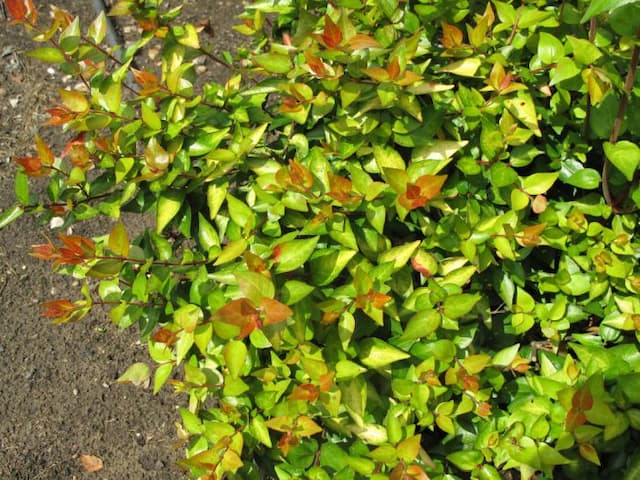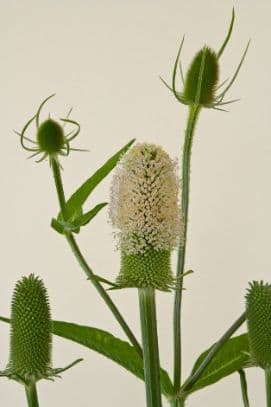Honeysuckle 'Red Gables' Lonicera periclymenum 'Red Gables'

ABOUT
'Red Gables' is a vigorous, deciduous, twining climber, to 7m tall, with oval, dark-green, bronze-flushed leaves, grey-green beneath. Clusters of fragrant, deep reddish-purple flowers, with cream interiors, are borne from summer into autumn and followed by red berries
About this plant
 Names
NamesFamily
Caprifoliaceae.
Synonyms
Honeysuckle, Woodbine, European Honeysuckle, Periclymenum.
Common names
Lonicera periclymenum.
 Characteristics
CharacteristicsLife cycle
Perennials
Foliage type
Deciduous
Color of leaves
Green
Flower color
Red
Height
5-7 feet (1.5-2.1 meters)
Spread
5-7 feet (1.5-2.1 meters)
Plant type
Climber
Hardiness zones
5-9
Native area
Europe
Benefits
 General Benefits
General Benefits- Attracts pollinators: Lonicera periclymenum 'Red Gables', commonly known as Honeysuckle, is known for attracting bees, butterflies, and other beneficial pollinators to the garden, helping to promote biodiversity.
- Aesthetic appeal: With its vibrant red and yellow flowers, the honeysuckle adds color and visual interest to garden spaces, making it popular for ornamental use.
- Fragrance: The flowers emit a strong, sweet fragrance, especially in the evening, which can enhance the sensory experience of a garden or outdoor space.
- Wildlife habitat: Honeysuckle provides shelter and nesting sites for birds, contributing to a wildlife-friendly environment.
- Easy to grow: It's generally easy to cultivate and can thrive in a range of soil types, making it accessible to many gardeners.
- Screening: The plant's dense growth habit makes it excellent for creating natural screens or hedges, providing privacy and reducing noise pollution.
- Support for structures: As a climbing plant, honeysuckle can provide natural coverage for arbors, trellises, or fences, enhancing the structural elements of a garden.
 Medical Properties
Medical Properties- This plant is not used for medical purposes.
 Air-purifying Qualities
Air-purifying QualitiesThis plant is not specifically known for air purifying qualities.
 Other Uses
Other Uses- Wildlife Habitat: Honeysuckle can provide shelter and a habitat for various insects, birds, and small mammals, offering them a safe place to nest and feed.
- Natural Dyes: The flowers and berries of honeysuckle can be used to create natural dyes for coloring fabrics or crafting materials.
- Perfumery: Honeysuckle's sweet fragrance is sometimes used in perfumery to capture the essence of a summer garden in scents and aromatherapy products.
- Garden Design: As a climber with attractive flowers, honeysuckle can be used as a natural decorative element in garden arches, trellises, and pergolas.
- Educational Resource: Honeysuckle can be used in educational settings to teach about plant life cycles, pollination, and the interaction of flora and fauna.
- Photography: With its picturesque vines and vibrant flowers, honeysuckle is often a popular subject for photographers and artists.
- Folk Art: The vines of honeysuckle can be dried and woven into traditional rustic crafts such as wreaths and other decorative items.
- Floral Arrangements: Fresh or dried honeysuckle flowers are sometimes incorporated into floral arrangements for their visual appeal and fragrance.
- Culinary Garnish: While not common, the flowers of honeysuckle can be used as an edible garnish to decorate desserts and other dishes.
- Soil Improvement: Honeysuckle can help prevent soil erosion and improve soil quality through its root system and organic matter from fallen leaves.
Interesting Facts
 Feng Shui
Feng ShuiHoneysuckle is not used in Feng Shui practice.
 Zodiac Sign Compitability
Zodiac Sign CompitabilityHoneysuckle is not used in astrology practice.
 Plant Symbolism
Plant Symbolism- Love: Lonicera periclymenum, commonly known as Honeysuckle, is often associated with love and affection, possibly due to its entwining growth habit, which can be seen as a symbol for a strong bond between people.
- Devotion: The Honeysuckle's tendency to cling to its support structures symbolizes devoted attachment, suggesting loyalty and a deep level of commitment.
- Happiness: The sweet fragrance and the abundance of Honeysuckle flowers are believed to bring joy and create a pleasant environment, symbolizing the sweetness of life and happiness.
- Generosity: With its prolific blooms and generous spreading nature, Honeysuckle may be seen as representing the spirit of giving and sharing with others.
- Protection: Traditionally, Honeysuckle is thought to ward off negative energies and evil spirits, making it a symbol of protection for homes and gardens where it is planted.
 Water
WaterHoneysuckle 'Red Gables' prefers moist, well-drained soil and should be watered regularly, especially during dry spells. The frequency of watering can be adjusted to about once a week, making sure the soil is moist but not waterlogged. During the growing season, it might require more frequent watering, particularly for plants in containers. It's important to avoid overhead watering to prevent leaf diseases. Generally, a good soaking with up to 2 gallons of water, ensuring it reaches the roots, is advisable each time you water.
 Light
LightHoneysuckle 'Red Gables' thrives best in full sun to partial shade conditions. It benefits from at least 6 hours of direct sunlight daily, but during the hottest parts of the day, some dappled shade can help protect the plant. The ideal spot would be one where morning sunlight is abundant and protection from harsh afternoon rays is provided.
 Temperature
TemperatureHoneysuckle 'Red Gables' is hardy and can tolerate a range of temperatures, flourishing in USDA zones 4 to 9. It can withstand minimum temperatures down to about -30°F and is comfortable in summer temperatures up to 90°F. Ideally, this honeysuckle variety prefers temperature ranges between 60°F and 80°F for optimal growth.
 Pruning
PruningPruning honeysuckle 'Red Gables' helps maintain its shape and encourages vigorous growth. It’s best pruned in late winter or early spring before the new growth starts. Thin out crowded branches and remove any dead or damaged wood. Pruning can be done annually, and occasional formative snips throughout the growing season are fine to keep it looking tidy.
 Cleaning
CleaningAs needed
 Soil
SoilHoneysuckle 'Red Gables' thrives in well-draining soil rich in organic matter with a pH between 5.5 and 7.5. A mix containing loam, compost, and a small amount of sand or perlite is ideal to provide the necessary nutrients and drainage.
 Repotting
RepottingHoneysuckle 'Red Gables' typically does not require frequent repotting and can be repotted every few years or when it becomes root-bound. In containers, repotting may be more frequent, every 2-3 years.
 Humidity & Misting
Humidity & MistingHoneysuckle 'Red Gables' is adaptable but prefers moderate humidity levels. It does not require specific humidity adjustments when planted outdoors in its natural climate.
 Suitable locations
Suitable locationsIndoor
Ensure bright light, well-draining soil, water regularly.
Outdoor
Plant in sun/part shade, fertile soil, water as needed.
Hardiness zone
4-9 USDA
 Life cycle
Life cycleLonicera periclymenum 'Red Gables', commonly known as Honeysuckle 'Red Gables', begins its life cycle when its seeds germinate in spring after a period of cold stratification. The seedlings grow rapidly, establishing a root system and producing vines that seek support and climb by twining around structures. During late spring to summer, the plant reaches the flowering stage, producing fragrant, tubular red to pink flowers that attract pollinators such as bees and hummingbirds. After pollination, these flowers develop into berries by late summer to autumn, which then ripen to a red or black color and are dispersed by birds and animals. The plant experiences a period of dormancy during winter, where growth slows down and the foliage may die back, especially in colder climates. In the following spring, the Honeysuckle 'Red Gables' emerges from dormancy, resuming growth from the existing root structure and completing the cycle.
 Propogation
PropogationPropogation time
Spring-Early Summer
Lonicera periclymenum 'Red Gables', commonly known as Honeysuckle 'Red Gables', is best propagated by taking semi-hardwood cuttings during the summer. To do this, select health non-flowering shoots and cut lengths of about 6 inches (15 cm) ensuring each cutting has several nodes. Strip off the lower leaves and dip the base of the cutting in rooting hormone to encourage root growth. Plant the cuttings in a mix of half peat and half perlite or coarse sand to provide good drainage. It's important to maintain high humidity around the cuttings, which can be achieved by covering them with a plastic bag or placing them in a propagator. The cuttings should be kept in dappled sunlight and not allowed to dry out until they have rooted, which may take several weeks. After rooting, the new plants can be transferred to individual pots and grown on until they are strong enough to plant out.








